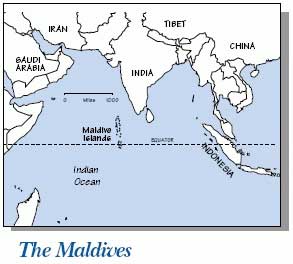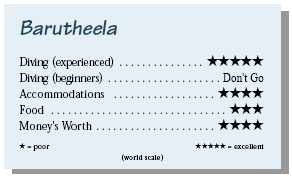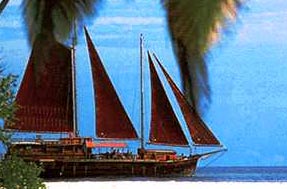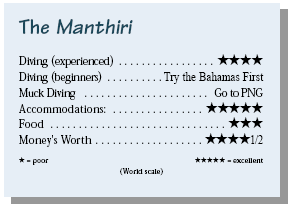Diving in the MaldivesContents of this Issue: What to Do if Your Automatic Inflator Sticks Open Editorial Office: Ben Davison Publisher and Editor Undercurrent 3020 Bridgeway, Suite 102 Sausalito, CA 94965 Aboard the Barutheela and the Manthiri from the August, 1998 issue of Undercurrent
Traveling to the other side of the world for the proverbial blow-your-booties-off diving is something we all dream of doing at least once in a lifetime. When it's time to turn that dream into a reality, however, you'd like assurance that two or three weeks of your time and a big bite into your savings will pay off with all the dynamite diving you want. With that in mind, we occasionally bring you these "dream trip" reports, so that when you're ready to take yours you'll have accurate and realistic information with which to plan. Luckily, one of our long-term travel writers, after two successful careers, can afford regular dream trips. We've relied on his reports for nearly a decade. In recent years he has journeyed aboard four different live-aboards in the Maldive Islands, which lure divers with some of the world's greatest diving--and an occasional disappointment. Here are his reports on the Barutheela and the Manthiri. Dear Fellow Diver: As I headed down the wall looking for shark action at the channel mouth of Embudhoo Express, Divemaster Ahmed Manik signaled me to look up. I rolled over and saw fourteen small mantas imitating the fast-action X-fighter scenes of "Star Wars." For five minutes they wheeled, dove, banked, and cartwheeled thirty feet above me--a memorable sight indeed. When I reached the mouth of the pass at 100 feet, an assortment of gray reef and whitetip sharks cruised the strong incoming current. Schools of big-eye jacks and midnight snappers hung above the sharks, and a few marauding dogtooth tuna glided by. I snared the reef with my reef hook and watched the action until my computer begged me to ride the current to shallower depths. . . .
Europeans have heavily influenced Maldivian diving. Typically, it's been two dives daily, one morning, one afternoon, and both deep. However, operators offering more dives per day are increasingly common, as are upscale boats with air-conditioning. On the other hand, because of the large number of divers visiting, the "dumb down" syndrome has hit hard here, as a brochure explains: no diving below 90 feet; no decompression dives, even if a dive computer is used; wearing a B.C. is mandatory; and divers must never dive alone. Because of the currents, dives are strictly limited to 60 minutes. Of course, when you've paid this much to come this far, it's only natural to chafe at such restrictions. Let me describe my most recent trip, which I took in March and April, 1998: The Barutheela It was not just the diving that lured me back to the Maldives, although the diving is so good that I really don't mind having a Singapore Airlines seat pattern permanently impressed on my butt. You see, as a mere lad I dreamed of sailing the Seven Seas with swashbuckling pirates and raven-haired lasses, so when I learned I could sail and dive the Maldives from a replica of an eighteenth-century galleon, I jumped at the chance. Two weeks diving with an international crew and guests from places as varied as Spain, Malaysia, Shanghai, and Australia from this 90-foot wooden ship with 200 square yards of rust-red sails definitely satisfied my dreams. The Barutheela (which, translated, means "Gift for a Queen") is a unique craft, with brass and copper fittings, two tall masts, and plenty of room above and below decks. My cabin was one of four below, with two others forward on the main deck. It was roomy, with a shower room and separate toilet, a big comfy bed, good reading lights, and a well-stocked book rack. They changed towels and sheets every two days and did personal laundry gratis. Off the galley, a small bar/salon with comfortable chairs carries a variety of alcoholic beverages, reading and reference books, and a music system with a good selection of CDs. Under the awning on the main deck are several lounge chairs, and sun worshipers are free to use the pads and chairs on the upper deck. The Maldivian, Indian, and Sri Lankan crew was cheerful, friendly, and helpful. The Barutheela has a spacious dive center aft, below the main deck, with a
high-volume electric air compressor, gear storage, and wetsuit hanging space. The
diving, however, is done from dhonis, traditional covered wooden boats about 30'
in length, which drop off and pick up divers. Unfortunately, there were a few
kinks in the system. Currents make Maldivian diving great, but they can be very strong and are almost always present, especially in the kandus (ocean passes leading into the reefs and atolls). Once you've come through the kandu, however, the current drops you onto the reef, where you can enjoy the macro, including crabs, anemones, pipefish, and cleaner shrimp. Other dives focus on the thilas and giris (reefs or pinnacles rising from depths of 75-100 feet to fifteen or fewer feet from the surface), beginning with a swim down the drop-off wall to the lip of the pass at 100 feet or so. Here a stay with the pelagics can be electrifying. Then, as your computer screams, go slowly up, take a ride down one of the inside channel walls or a mid-channel pinnacle, and drift along observing the wonderland of color and life. A variation on the theme could be a dive on one of the more than thirty-five known wrecks. All dives are on designated dive sites, so dive quality is generally dependable. Even Banana Reef, a heavily-dived site in view of Male, the capital city, provided a good shot at a stone fish the size of a bowling ball as well as a profusion of eels and a never-ending stream of pennant butterflyfish. Suboptimal dives occurred when the timing was wrong and the current clouded the water, which is why proper dive planning by a divemaster and dhoni team who know how to read the water and the dive site are essential. Unfortunately, dive planning and briefings on the Barutheela were often inadequate. Divemaster Moojay and his brother and dhoni helper, Suzan, were used to their usual two-dive-a-day routine.
Although friendly and accommodating, they weren't prepared for the fourdive- a-day schedule our group pushed for--and the compressor problems didn't help matters any.(We contacted the Barutheela, which acknowledged persistent difficulties getting the generator repaired. They have organized a new dhoni equipped with radio and oxygen.-Ed.) Still, whenever I jumped into the water, my first thought was always "wow, look at all these damn fish!" To add to that, all the hard and soft corals are alive and beautiful--perhaps not up to some of Fiji's better spots, but certainly world-class. Because the Maldivians historically ate only skipjack tuna, the fish life is plentiful and pulchritudinous: it's estimated that there are 1,000 species of fish in the Maldives, compared to 300 species in the Galapagos and 200 in the Caribbean. Diving from a replica of a galleon is a great concept, but concept's one thing and execution something else again. The friendly and accommodating Austrian owners, who have been aiming at the European market, were not set up for the demands of the Asian/American divers we had on my trip. Several video camera batteries failed, presumably due to 165-volt (rather than 220V) current coming off the main generator. It also took several days to get the air conditioning adjusted so that the cabins were comfortable. The crew served meals under a large canvas awning on the main deck, a comfortable place given the almost-constant breeze. While I'm not choosy about when I eat, several guests became annoyed at our erratic meal times. Because of problems with moving to different sites, tank fillings, uncertainty about which sites to dive, and lack of communication among the staff, meals often ran a couple hours late. When we did eat, quality varied, probably because the eager-to-please kitchen staff changed their usual menu suited Asian diver's palates. I suspect the meals would have been better if the chef had stuck to his usual Sri Lankan and Indian specialties. Despite the shortcomings, I enjoyed the trip. The diving was first-rate most of the time. Relaxing on the main deck of a Spanish galleon, sailing past brilliant green islands and chatting with an international cast of guests was, for me, a flashback to my boyhood dreams. But, unless you harbor the dreams I did, the next boat I describe, the Manthiri, a big, clean, and comfortable Aggressor/ Peter Hughes live-aboard clone, is probably a better choice. The Manthiri Thanks to its high-quality dive operation, the Manthiri stands out. Divemaster Ahmed Manik, a thin, bearded, almost spiritual Maldivian, knows these waters and works hard to provide good diving. His briefings use a white board with colored markers on which he plots and plans each dive like Eisenhower outlining the invasion of Normandy. He sketches in the features of the dive site, drawing in current possibilities and providing several options we tended to label "Plan A and Plan B." After the briefing, he leads the divers down the ladder to the dedicated dive dhoni. This support boat is well organized, with a crew of three, an onboard compressor, rinse tanks, and baskets for gear and oxygen. The crew sets up divers' gear on either 94 c.f. steel tanks or aluminum 72s--then helps them don it. I used the big steel tanks and enjoyed the extra air.
Before the dive, Manik or his assistant, Moosa, enters the water to check current and visibility and ensure that the dive will be a good one; on several occasions we motored to another site to find better conditions. Underwater, Manik enthusiastically points out the wonders below, and, after the dive, the crew takes gear handed up. Not all my dives were great, but many
were. After catching the fourteen mantas
on the inside channel of Embudhoo Express,
I relished the prolific reef life that makes diving the Maldives so enjoyable.
Fending off anxious anemone
fish, I peeked in many anemones to
discover the elusive porcelain crabs.
Green morays as large as Arnold
Schwarzenegger's thighs gaped from
their holes, while clouds of colorful
fusiliers swirled above. Fotheyo Caves, a site rivaling the Great White Wall in Fiji, provided festoons of soft corals that lit up like neon under my dive light. Maya Thila, with resident gray reef and silver tip sharks, big bait balls, jacks, tuna, surgeonfish, and spadefish, is one of the best sites in these atolls. Broken Rock's split pinnacle at eighty feet afforded an enormous school of barracuda and sea fans as big as full-sized bed sheets. After the dives, the dive staff provided plenty of clean towels at the aft shower and camera rinse tank area. We usually had three--and occasionally four--dives daily (including night dives, if any). The night dives were not a regular occurrence because of the need to anchor out of the currents and the deep diving that had preceded them during the day. Besides the excellent dive operation, the three-deck Manthiri (Maldivian for the bishop on a chess board) is a fine boat which sports six guest cabins below decks; cabins three and four feature queen beds, the rest twins (not bunks). I recommend cabins two and five amidships; cabins one and six, which are aft, are noisier and can pick up diesel fume odors. All are roomy, with lots of storage space and real bathrooms (not marine heads) that are practically as large as the cabins on other live-aboards. A steward makes up the rooms several times daily, changing towels and sheets every couple of days. Laundry service is free, and each cabin also has 110- volt outlets for American plug-ins. A reserved but friendly crew of ten keeps it all working smoothly. The large salon/dining room on the main deck has several large upholstered sofas, coffee tables, two dining tables, and bookcases stuffed with reference and reading material, a TV/VCR, and a music center. A mixed bag of video movies provides amusement for insomniacs, and two large auxiliary cooler units keep this area comfortable. The water maker furnishes plenty of water, and generators run the air conditioning and electrical system 24 hours a day. The top deck has chairs in both shaded and sunny areas. Chef Savad provided a mixed bag of comestibles. The pre-breakfast, pre-dive offering was always packaged cookies and tea and coffee. Breakfast after the morning dive usually featured eggs (poached, scrambled, omelets, or hard-boiled), chicken-based "ham," sausage, bacon, toast, and fruit (sometimes fresh). Lunches were often fish or meat curry. Dinners were usually better than the lunches, with southern-fried chicken, beef stroganoff, rigatoni, broiled marlin, and tasty fish or chicken curries. Dinner was often postponed until after the night divers returned, which meant that some main courses were served unpleasantly lukewarm. One night the crew put on a surprise beach barbecue, bringing us by dinghy to a sand spit, where they had dug a sand picnic table, placed dozens of oil lamps, and made sand sculptures of fish. With the skies full of stars, the bioluminescence made the lapping waves sparkle like miniature fireworks: it was indeed a memorable evening. Another evening we visited a Maldivian drum and dance performance at a fisherman's village. In the small performance room, the overwhelming tropical heat, blinking Christmas lights, hammering drum beat, and fleeting shadows cast by male whirling dervishes blurred into an experience almost psychedelic in its intensity--quite a Maldivian memory. Too often live-aboard trips conclude abruptly, with passengers being dropped at the airport for a long wait. Not here. We got to visit Male for shopping and sightseeing, have dinner on board, and take final showers before going to the airport. So what did I think of the Maldives? The fact that I've been there four times says a lot. I'd recommend filing this issue away until you're ready to make that dream trip a reality--after all, that's why we punch those three holes on the side of each issue. -- E.E.
|

I want to get all the stories! Tell me how I can become an Undercurrent Online Member and get online access to all the articles of Undercurrent as well as thousands of first hand reports on dive operations world-wide
| Home | Online Members Area | My Account |
Login
|
Join
|
| Travel Index |
Dive Resort & Liveaboard Reviews
|
Featured Reports
|
Recent
Issues
|
Back Issues
|
|
Dive Gear
Index
|
Health/Safety Index
|
Environment & Misc.
Index
|
Seasonal Planner
|
Blogs
|
Free Articles
|
Book Picks
|
News
|
|
Special Offers
|
RSS
|
FAQ
|
About Us
|
Contact Us
|
Links
|
3020 Bridgeway, Ste 102, Sausalito, Ca 94965
All rights reserved.

 For North Americans, the beautiful
Maldives are halfway around the world--
and then some (taking about the same
time to reach as PNG or Sipadan). Here,
among nineteen clusters of hundreds of
sandy, low-lying, palm-studded tropical
isles, divers visit more than seventy
island resorts, scores of rustic, oldstyle
"safari boats," and a few modern
live-aboards. I suspect that in prime
season no other dive destination on the
planet has more divers in the water (especially
divers from Asia and Europe).
For North Americans, the beautiful
Maldives are halfway around the world--
and then some (taking about the same
time to reach as PNG or Sipadan). Here,
among nineteen clusters of hundreds of
sandy, low-lying, palm-studded tropical
isles, divers visit more than seventy
island resorts, scores of rustic, oldstyle
"safari boats," and a few modern
live-aboards. I suspect that in prime
season no other dive destination on the
planet has more divers in the water (especially
divers from Asia and Europe). The Barutheela's main compressor was down, so the crew filled tanks from a low-volume, lowspeed
compressor on the support dhoni,
which took three hours or more to refill
all the tanks. There were no tank racks
or rinse buckets for camera/video gear,
and the short ladder was a problem for
some divers. Dive gear was stored in
bags on the deck rather than in boxes as
on other boats. Oxygen is kept on the
Barutheela, not on the dhoni.
The Barutheela's main compressor was down, so the crew filled tanks from a low-volume, lowspeed
compressor on the support dhoni,
which took three hours or more to refill
all the tanks. There were no tank racks
or rinse buckets for camera/video gear,
and the short ladder was a problem for
some divers. Dive gear was stored in
bags on the deck rather than in boxes as
on other boats. Oxygen is kept on the
Barutheela, not on the dhoni.

 A Napoleon
wrasse nearly the size of a new
Volkswagen cruised by, spinning his
eyeballs at me, and I closed in on a
couple of unconcerned wash-basin-sized
turtles. Then I drifted through a large
nest of wildly-aggressive titan trigger
fish; luckily, this year I avoided the
frenzied fin-biting I experienced on a previous run. On a long safety stop on the
reef top, I gawked at butterflyfish in their matrimonial pairs and flashing clouds
of jewelfish anthias. At the prescribed sixty-minute resurface time I floated up,
signaled the dhoni, and away we went.
A Napoleon
wrasse nearly the size of a new
Volkswagen cruised by, spinning his
eyeballs at me, and I closed in on a
couple of unconcerned wash-basin-sized
turtles. Then I drifted through a large
nest of wildly-aggressive titan trigger
fish; luckily, this year I avoided the
frenzied fin-biting I experienced on a previous run. On a long safety stop on the
reef top, I gawked at butterflyfish in their matrimonial pairs and flashing clouds
of jewelfish anthias. At the prescribed sixty-minute resurface time I floated up,
signaled the dhoni, and away we went. Diver's Compass: In-air flight times to the Maldives are comparable
to other Pacific destinations (±18 air hours)....19
international carriers service the islands, including
Singapore Air and Malaysia Air, both good airlines with a
generous luggage allowance, plus overnight in Singapore is a
good option ....main choices for live-aboards are Barutheela,
Manthiri, and Madivaru 7, a beautiful boat with a lot of deck
space reported to have its act together on diving and
food....the Madivaru's small salon makes it preferable during good weather....the
Manthiri's small deck/large salon is preferable if the weather's bad....Contact a
dive travel agent or Manthiri at 011-960-325634....Madivaru at 011-39-
39329338....Barutheela: (telephone: 43-316-81-01-49, fax: 43-316-81-38-54,e-mail:
Diver's Compass: In-air flight times to the Maldives are comparable
to other Pacific destinations (±18 air hours)....19
international carriers service the islands, including
Singapore Air and Malaysia Air, both good airlines with a
generous luggage allowance, plus overnight in Singapore is a
good option ....main choices for live-aboards are Barutheela,
Manthiri, and Madivaru 7, a beautiful boat with a lot of deck
space reported to have its act together on diving and
food....the Madivaru's small salon makes it preferable during good weather....the
Manthiri's small deck/large salon is preferable if the weather's bad....Contact a
dive travel agent or Manthiri at 011-960-325634....Madivaru at 011-39-
39329338....Barutheela: (telephone: 43-316-81-01-49, fax: 43-316-81-38-54,e-mail:
